Crafting the look of What We Do in the Shadows Season 6
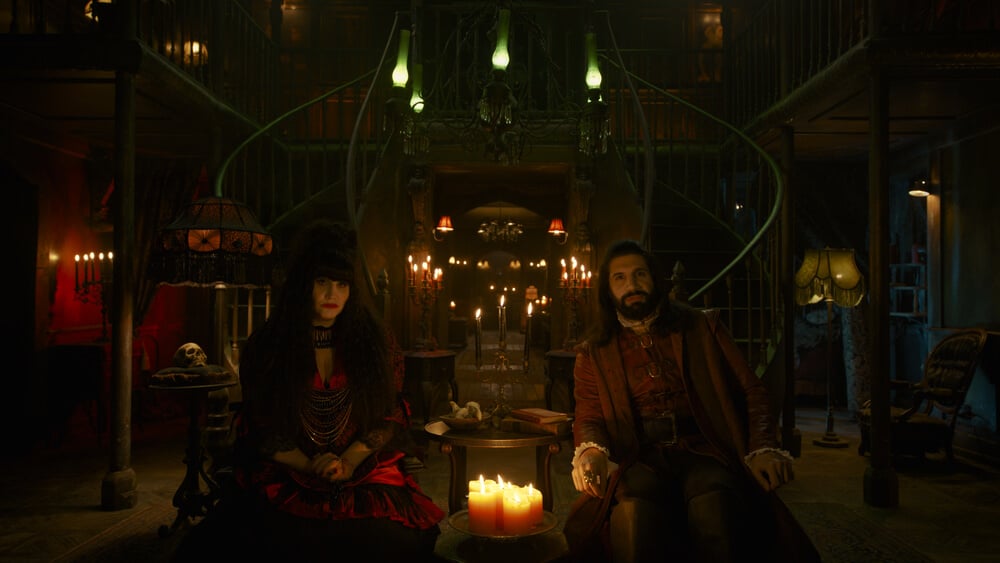
What color is the ghost of a vampire’s deceased father? Though it sounds like the setup to a punchline, it was one of myriad questions requiring a serious answer from lead cinematographer Bevan Crothers and producer Todd Aronauer for the sixth and final season of FX’s mockumentary series What We Do in the Shadows. In tackling such questions, they collaborated closely with Light Iron senior colorist Ethan Schwartz, who’s been part of the Shadows team since the show’s first season, when he worked as an additional colorist alongside Light Iron supervising colorist Ian Vertovec; since Season 2, Schwartz has served as the show’s main colorist. Together, Crothers, Aronauer, Schwartz and Light Iron associate DI producer Christopher Riggs helped ensure Season 6 would maintain an overall visual consistency with the previous seasons while also guaranteeing the last one broke new ground and went out in bloodcurdling style.
A native of New Zealand, Crothers cut his teeth as a cinematographer and camera operator in documentaries and mockumentaries and worked with writer-director Jermaine Clement on the comedy series Short Poppies. When Clement’s and Taika Waititi’s 2013 vampire feature, What We Do in the Shadows, became an international sensation, Clement offered Crothers the chance to shoot the spin-off mockumentary television series Wellington Paranormal. Crothers later jumped on one of Clement’s subsequent TV projects, Time Bandits, as one of the main-unit cinematographers. Working on that series led to the opportunity to join the final season of FX’s What We Do in the Shadows as the show’s lead cinematographer.
The post producer on Shadows since its fifth season, Todd Aronauer started his career in the film and TV industry as a production assistant in the late 1990s for the ABC TV series Sabrina the Teenage Witch. He soon gravitated toward post production, which he’s found has required him to have his hands in every aspect of production, from being part of the creative discussions with writers, directors and network executives at the onset of a series, to working with cinematographers and other key crew members during the principal photography, and even dealing with business affairs and clearances for editorial. Over the course of his career, he has overseen post production on such series as Supernatural, Ginny & Georgia and English Teacher.
After What We Do in the Shadows wrapped and the filmmakers bid farewell to the show’s iconic cast of characters — including Nandor (Kayvan Novak), Laszlo (Matt Berry), Nadja (Natasia Demetriou), Guillermo (Harvey Guillén) and Colin Robinson (Mark Proksch) — we caught up with Crothers, Aronauer, Schwartz and Riggs to discuss their collaboration on the series’ epic conclusion.

Light Iron: Bevan, you’d shot a number of mockumentaries previously. How did those experiences translate to What We Do in the Shadows?
Bevan Crothers: I’m passionate about mockumentaries. They all have their own set of rules that have to be set up at the beginning. When I joined Shadows, I needed to work out what those rules were. How interactive and involved is the camera? How much does it react with what the characters are doing? How much zooming is there? How many cameras are there? You want your cameras to be working hard so they’re chasing whatever’s happening. Shadows tends to be two to three cameras because there’s generally a large cast — it can be up to six people, and you need that coverage. Director Yana Gorskaya and I would often drop to two cameras to help create the documentary feel of the show.
How would you describe the look of the show?
Crothers: The show’s got two edges to it. The vampire world is dark, colorful and slightly theatrical with its lighting, color and the costumes — lit by candles and moonlight, it’s beautiful, and the mansion is old and Victorian. The human world is boring, stark and quite mundane.
One of the major things for me visually is that Shadows started in Season 1 lit heavily by candles, tungsten lights and HMIs, with moonlight coming through windows and the odd camera light smashing the face of the actor. It had similar tones to the original feature film. But then across the entire series the LED revolution happened. This series for me is a big flagship for seeing the development of LED from Season 2, when there starts to be more color and where the uplighting on the wall started to kick in. By the beginning of Season 3 the show was well into its look and lighting structure.
Ethan Schwartz: I feel like the technical evolution could also be seen, in a way, as part of the story. As the vampires got more comfortable with the crew, the crew was able to add more lights, dress the set more, introduce new characters, and increase the production value overall, like any successful show. With that evolution, I was also evolving my color workflow to tweak the colored gel lights to get that perfect pale lavender moonlight or take advantage of improved tools in Baselight to create windows on eyes and faces much faster. Every season I found new and better ways to enhance the grading while maintaining that original mockumentary feel that we all loved.
Has that evolution also meant that there have been changes over the years to the show LUT used during principal photography?
Schwartz: The show’s shooting LUT was originally built from the S-Log3/S-Gamut3 Venice 709 with some creative adjustments to help visualize the final. However, when HDR became a requirement in Season 3, I rebuilt the look in Baselight. As the seasons went on, I would refine the look each time to achieve better skin tones for the vampires or change the highlight roll-off to allow a smoother candle flame or moonlight. There’s a darkness yet vibrancy that’s a signature of the show.

Todd, it’s often said that post production starts in preproduction. Does that align with your experience?
Todd Aronauer: Every department that is worth their weight knows it’s how much you prepare for a job beforehand that makes it that much easier to pivot when you need to. As much as you plan for something, once the cameras start rolling, things change, and the same thing happens in post. The common adage is ‘we’ll fix it in post,’ but that diminishes what other departments do throughout the process that continually elevates the show as it progresses. Of course post is an unsung hero of every production, but how well a show preps can really make or break the final product.
With the finale, among all the many usual details to wrangle, the logistics of shooting 16mm film — both color and black-and-white — along with our series-standard Venice cameras was quite a bit to coordinate. There aren’t too many film labs left that develop 16mm, and even less that develop black-and-white. Production was in Toronto, and we worked with FotoKem in L.A. to develop and process our footage. Shipping undeveloped negative across borders can get a bit complicated to set up properly, to ensure it doesn’t get X-rayed or mishandled in any way that might destroy our material.
How did your conversations begin with Light Iron?
Aronauer: When I joined the show for Season 5, that was my first time working with Light Iron. My initial discussions with Christopher Riggs and the team at Light Iron went through every process — turnovers for online, VFX and color, through drop-ins and final deliveries — before we ever got to those stages. With Season 6, as soon as we knew basic storylines, I was able to discuss with Light Iron specific aspects, looks and formats that would affect the shooting process for the desired final look.
Ethan has been absolutely great to collaborate with. He’s a great source of knowledge. He’s somebody I contact often, as well as Christopher Riggs. The three of us are able to throw questions to each other, and that open communication helps me go back to my team and say, ‘Here are some parameters for our sandbox. We’ll have more leeway if we stay within this structure.’ It’s always very collaborative with Light Iron, and I absolutely value and appreciate everything they did for the show.
Crothers: I’d heard about Ethan before coming to the show, and everybody raved about him. I rang him up during my prep — he’s a total resource for a DP coming into a series like this and understands the look and the feel of the show. He knows when other DPs did things that may have worked or not worked, and I wanted to know whatever he’d had to deal with when it came to the show. When you’re shooting a scene from start to finish, if it’s a long scene, the haze levels start to change and shift. Maybe one take had lots of haze and another didn’t, or an actor might not hit the spot that they hit in the last take, so the lighting’s slightly different. Ethan does a lot of work helping with leveling and creating consistency.
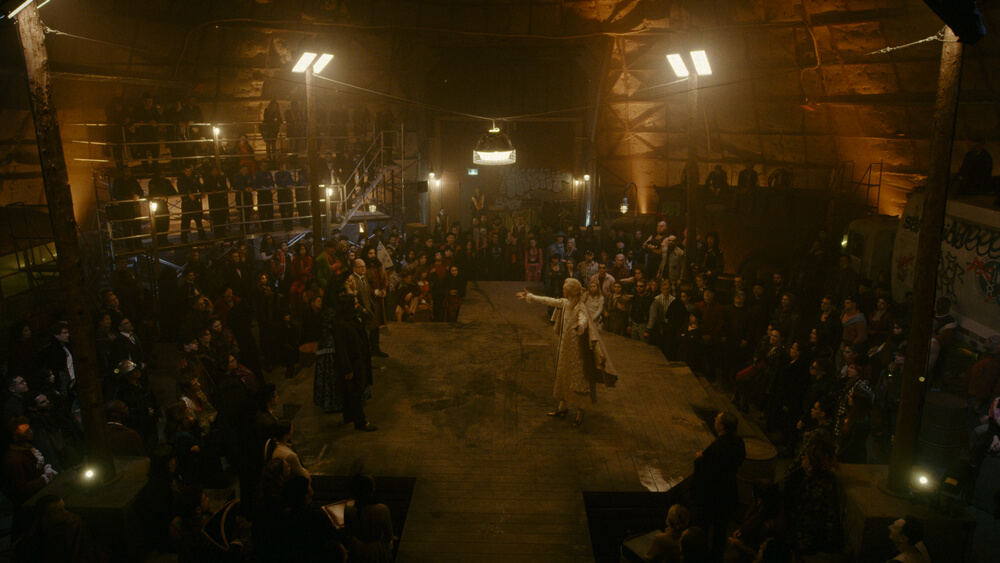
What were some of the other main areas of focus in the final grade?
Crothers: One big thing we worked on is moonlight. The moonlight is a pale lavender over a 5600K light, LED or HMI. It needs to be desaturated a certain amount to create a silvery feel or else it starts to look lavender-purple. For me, it’s a fine line between this working and not.
On set, we tended to run the white balance at 4300K and then light everything either colder or warmer from that point. Sometimes the candles become too warm. For me, it’s always about never feeling it’s too lit. It’s a colorful show that has that slight theatrical feel in the mansion, without feeling like it’s gone over the top. This was a big thing to protect in the final grade.
Christopher Riggs: Bevan, Ethan and Yana have worked hard to bridge the line between a natural-feeling aesthetic while also maintaining that theatrical and extravagant look. The show is also generally dark, so balancing that on set and in the grade while maintaining contrast and definition in the lower end — allowing things like Nadja’s hair, the actors’ costumes and props to all maintain their detail — is part of the feel of the show.
Crothers: Ethan has an incredible eye for subtleties of color and shifting of exposures. There are so many things I thought looked great and then Ethan would add magic and elevate the visuals.
In a mockumentary, consistently getting light in the actors’ eyes is one of the hardest things to achieve. Ethan was a huge help in that area with his ability to lift and enhance the vampires’ eyes. Nadja has a long dark fringe, so her eyes would go dark quickly. It’s great to dig into the shadow detail and pull them back up into a good place.
Schwartz: Mockumentary is a challenging genre to grade. There’s a balance between making it feel like a real documentary and a dark, vampiric world. Over the seasons, [the series’ initial lead cinematographer] D.J. Stipsen and Bevan gave me incredible images to work with and allowed me to push the style at times. Since the cameras needed to follow the characters like a documentary, they couldn’t light in a traditional way, so I needed to bring up actors’ faces and eyes quite often. I’d also use power windows to direct the viewers’ eyes to the action.
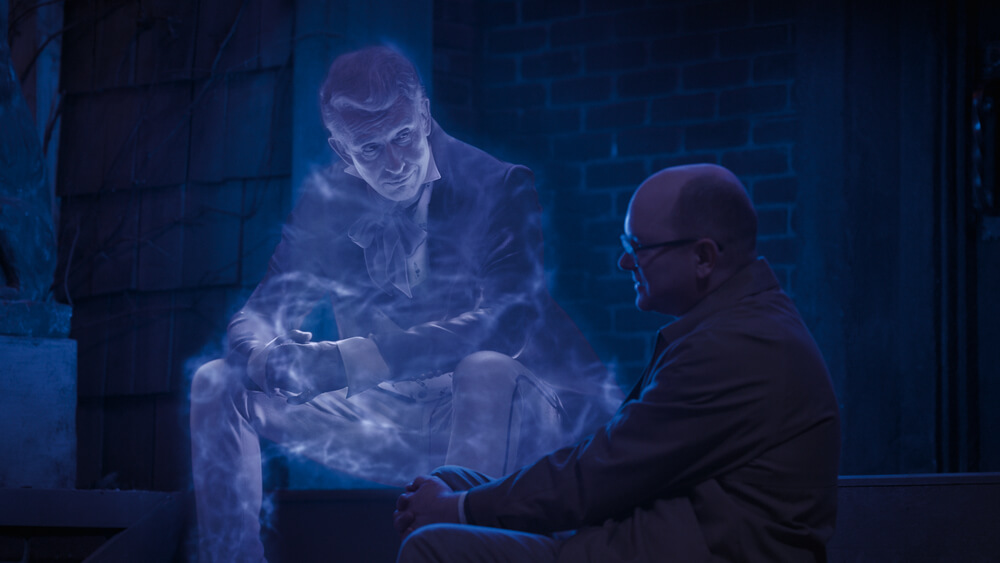
Were there specific episodes this season that posed their own unique coloring challenges?
Riggs: Episode six, ‘Laszlo’s Father,’ was one of the more exciting and challenging episodes to work on as there were over 200 VFX ghost shots, where Bevan had basically wrapped an actor in LED lights that interact with all the elements in the scene. Ethan and Bevan spent a lot of time dialing-in the look of the ghost and how the blue light emanating from it interacts within all the scenes.
Crothers: The ghost of Laszlo’s father is played by Steve Coogan, who wore an LED vest that lit him and anything around him. Basically he was a moving light. The biggest challenge with that was the vest and all those LEDs had to be taken out by the VFX team for the final result. We started with the original vest of LEDs they’d used for a ghost character in a previous season. The color of the ghost had already been established. I wanted to keep it within that same world, with the same blue tone, to keep the continuity of look and feel for ghosts in this world.
The original LED vest was quite big, and LEDs have come a long way. They’re more streamlined and controllable now and emit a better quality of light. One of the electricians started creating a new set. We made some prototypes to try out and establish our lighting intensity and color. We designed a diffusion tube to fit over the LEDs to soften and spread the blue light on Steve’s face. We also programmed multiple clusters of color-matched LEDs, rigged above set, to mimic and match the ghost’s movements in each scene. This allowed us to spread the effect from the ghost’s light further. It created a much more interactive feeling.
Schwartz: The ghost was a fun challenge to tackle. The LED suit worked amazingly well and gave me plenty of light to adjust the colors. Once we got some of the first temp VFX back, we were able to see how transparent our ghost would be. I was then able to selectively bring that blue color down in luminance, which allowed us to see through better and gave more dimensionality to his body. I used one of Baselight’s newer tools, X-Grade, to achieve very smooth and precise color adjustments.
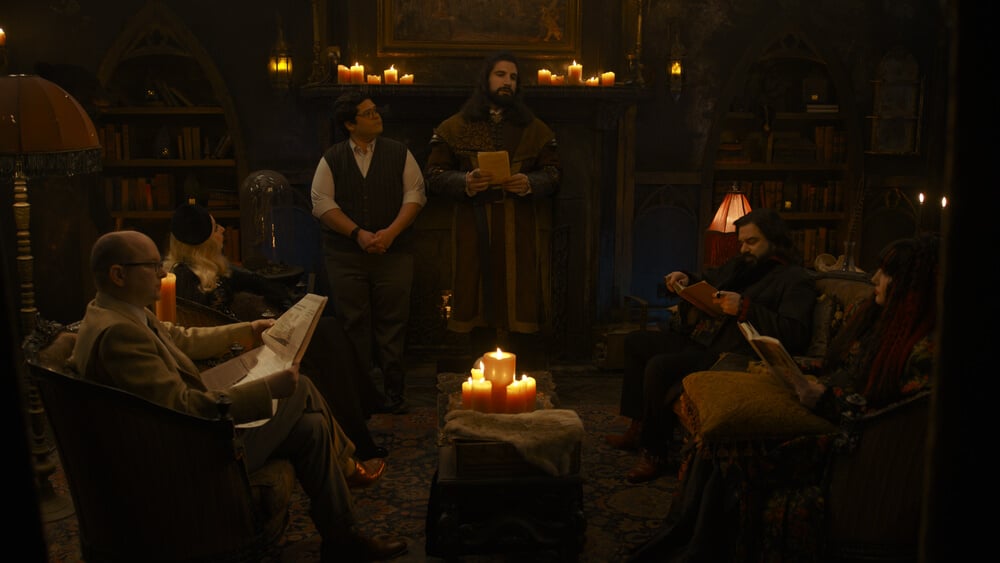
After six seasons, the vampires’ mansion is a character in its own right. Bevan, how did you approach lighting the mansion’s interiors?
Crothers: I really wanted to keep the consistency of tone and feel of the lighting from previous seasons — uplighting on the walls, the green chandelier, the candles, the warmth of the mansion versus the darkness of outside. Keeping the downstage camera side dark was important to me, giving it a horror-comedy feel. The mansion has very established colors, and I wanted to keep those colors dirty. If it was cyan splashed up against the dark wall, that cyan was tweaked a little bit muddy and horror-like to stay away from it becoming too pretty. I was trying to keep the lighting and color within a dark vampire world while never allowing those accents and hues to overthrow the characters. I always wanted to feel like they were mainly lit by chandeliers or candles.
During the final episode, Yana decided she’d like to see the documentary crew packing up. We discussed, ‘What if all this color that’s come into the show, the LEDs, the documentary crew has put all that in?’ We designed a lighting story, and through this final episode you see the documentary crew actively pulling all those lights out. There’s a scene where Nadja and Guillermo come from the mansion hallway into the foyer, and there are two lighting people walking down the stairs holding green LED tubes, which were enhancing the green light from the chandelier. After that, you never see that green backlight again. The lighting plan was designed so all that color starts to get stripped away to create a payoff at the end, where it starts to look like the first season again, the first episode.
How did you deal with the shadows in Shadows?
Crothers: Ethan and I worked to keep all the shadows looking nice and solid with as little noise in them as possible. We were shooting on the Sony Venice, which has a 2500 ISO base, I shot everything at 1600, so I was slightly over-lighting and then bringing the picture down with the on-set colorist. Ethan could then manipulate everything. It’s a dark mansion, the walls are dark, everything’s dark, so this helped protect those shadowed darker areas and keep it nice and clean. As you pull them back to the desired level, the shadows drop down into a nice dark place. Ethan could grab something and pull it up and it wouldn’t start to fall apart or cause noise.
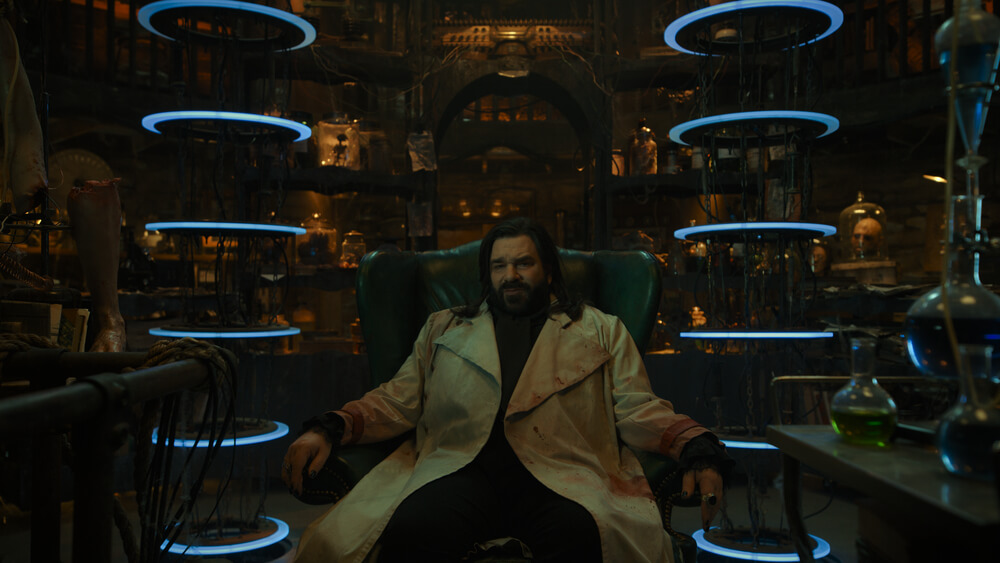
Michael Storey shot five of the episodes in Season 6. Bevan, how did the two of you collaborate to ensure your episodes would all feel of a piece?
Crothers: Michael had already been part of Seasons 4 and 5 and already knew the show. I had a good amount of prep. Once I landed in Toronto I reached out to Michael, introduced myself, and got his insights on the show. I was the lead DP, but the first episodes I filmed were episodes three and five. There were sets that I’d worked on with the production designer, lit and tested and then handed off to Michael. He then established these sets in episodes one and two. I’d explain what I’d done, and then he would add his own touches to them. When it came to actually doing our episodes, we had really different episodes. Michael and director Kyle Newacheck, their storylines were orientated more towards Laszlo’s laboratory and the Cannon Capital offices. My episodes with Yana had very few scenes in these sets.
When I was confirmed for the job, I rewatched the whole series. Firstly because I wanted to make sure I knew all the storylines, and then I rewatched it purely for the lighting and camera. One thing I noticed rewatching the show was that there was a bit of individual interpretation of how the moonlight was or how green the chandelier in the foyer is. The fundamentals were the same with slightly different styles applied.
D.J. Stipsen was cinematographer for the original feature and then the lead DP for the first four seasons of the show, and he directed episode nine this season, ‘Come Out and Play.’ How was it collaborating with him?
Crothers: Episode Nine was one of the bigger episodes, with hundreds of vampires, a lot of locations and large blocking pieces. We had seven days of shooting instead of the standard six. It’s based off The Warriors, and it’s a big chase sequence with multiple fights. Our Staten Island vampires are being chased by all the other vampires. D.J.’s a good friend from New Zealand, and I realized it was quite a unique situation — I was the DP for the director who was the original DP and knows more about the look of the show than anybody. It was great, we found our flow, and it was great to work with another Kiwi with such an incredible Canadian crew.

Todd mentioned shooting 16mm film for the final episode. How was that incorporated?
Crothers: The first thing we shot was a black-and-white scene. There is a scene where the vampires set up a projector screen and they’re watching an old 16mm documentary about vampires. Yana came up with this really great reference of the Maysles brothers’ documentary Salesman. In our show, the Maysles brothers shot our documentary about vampires, but it never aired. We discussed that we could do a lot of post effects to create a feel like film, but then decided ‘why don’t we do it for real and actually get the grain and feel?’ So we shot it on 16mm black-and-white Kodak Double-X 7222, with zooms, framing at 1.33:1.
I hadn’t shot film for maybe 20 years, so to suddenly do an approximately four-page scene with all our core cast, special effects, VFX, three cameras, and running every take from top to bottom, I definitely had a moment of thinking, ‘this is going to be intense.’ During prep for this episode, we brought in a second crew, with film experience, to test with two stand-in doubles, who were dressed in similar wardrobe to Nadja and Laszlo. We had mannequins with costumes and applied different shades of makeup to their faces to test the tones in black-and-white. We looked at the reds and blues and greens so we could work out the amount of contrast on the black-and-white film. I think it really came out great!
Schwartz: I really enjoyed going back to work on 16mm black-and-white film. It reminded me of shooting black-and-white reversal on a Bolex during film school. Since the film stock was specifically chosen for its look, once we were in the grade, I was just finessing small details and making sure it matched the references.

The finale also has a surprise ending — or endings, to be more specific. Todd and Bevan, can you describe what was done?
Aronauer: I don’t know of any series that has tried this before — we aired three different versions of the finale on the same night on FX, a Usual Suspects version at 10, a Rosemary’s Baby version at 10:30 and then a Newhart version at 11. We also delivered just the hypnosis scenes that could be viewed as additional content on Hulu as well as a fifth delivery of the Usual Suspects version with the alternate scenes included at the end after the credits. Nadja looking at the camera and using her vampire hypnotism on the audience was really helpful keeping it all in context.
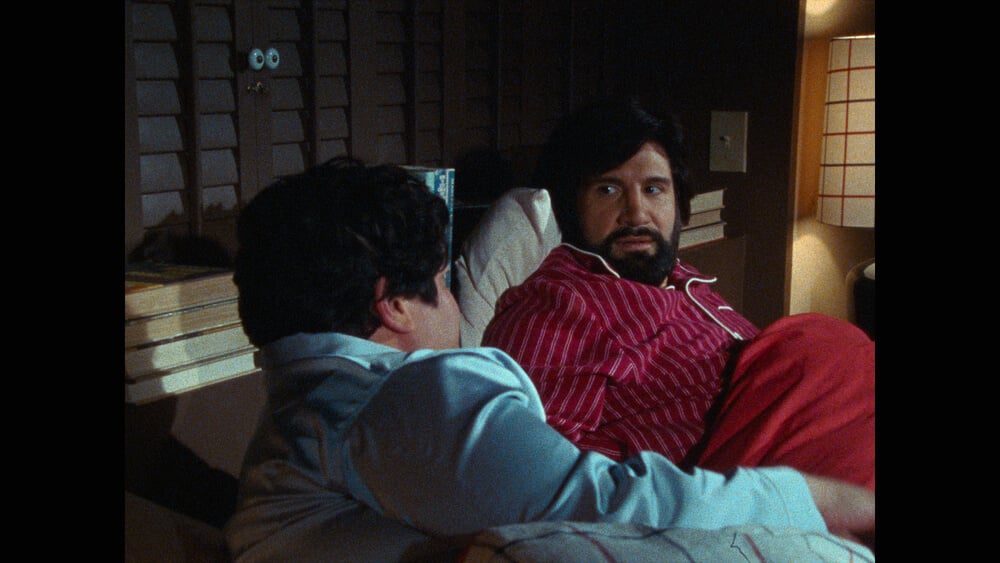
Crothers: One of the endings basically mimics the ending of Newhart, when Bob Newhart wakes up and realizes the whole thing was a dream. We replicated that scene, which was originally shot on 35mm, with the same 16mm cameras we had on board, shooting 16mm color with Kodak Vision3 500T 7219. We shot and lit it frame-for-frame with Nandor and Guillermo.
For one of the other endings, the art department built the police-station set from the end of The Usual Suspects. For this, Kevin Spacey’s role is played by Colin Robinson, who did such a great job. We shot it all drama-style, completely away from the mockumentary feel. It was again shot-by-shot, mimicking the same push-ins and cinematic moments.
Then the third ending is Rosemary’s Baby. The art department again did an incredible job turning the music room set in the vampires’ mansion into the Rosemary’s Baby room with the bassinet, where Mia Farrow’s character comes in and asks, ‘What have you done to my baby?’ In Shadows, that role is played by Nadja, wearing the blue dress, holding the knife. We shot that and the Usual Suspects ending on the Sony Venice with a variety of older lenses. When I joined the color grade with Ethan, we added some film weave, 35mm textures, and it was great to create a similar aesthetic to these iconic endings.
Schwartz: I spent quite a bit of time revisiting all of these films and tv show to wrap my head and eyes around the look. Once I was confident with the match, it became about how these films felt in our memory, and how they played into the vampires’ world. It was incredibly enjoyable to recreate looks from some of my favorite films.

Todd, does having different endings for different distribution platforms add more wrinkles to the post-production process?
Aronauer: Yes, it adds additional deliveries, different QCs, different timings, mixes, color correction, and closed captioning for all the localization teams down the line. Jonathan Frank and his team at FX went to great lengths trying to keep this a secret.
It’s a lot, but for me, these puzzles are why I do what I do. Shows like this that do things differently are what keep things interesting. It’s not the same episode week after week.
Bevan, what has it meant to you to be lead cinematographer on the final season of this series?
Crothers: I’m exceptionally proud of it. It was a massive opportunity for me, and I went in going, ‘I’m going to punch up as high as I can.’ Being that the feature film originated in New Zealand and is so iconic there, I felt honored, as a New Zealander, to have finished the show with such an amazing team. And as far as endings go, I think episode 11 pays off so well and is so respectful to the audience, the story and the characters. I’m blown away to have shot the final episode, but at the same time, I wish this was just a hiatus and we were coming back for more!
